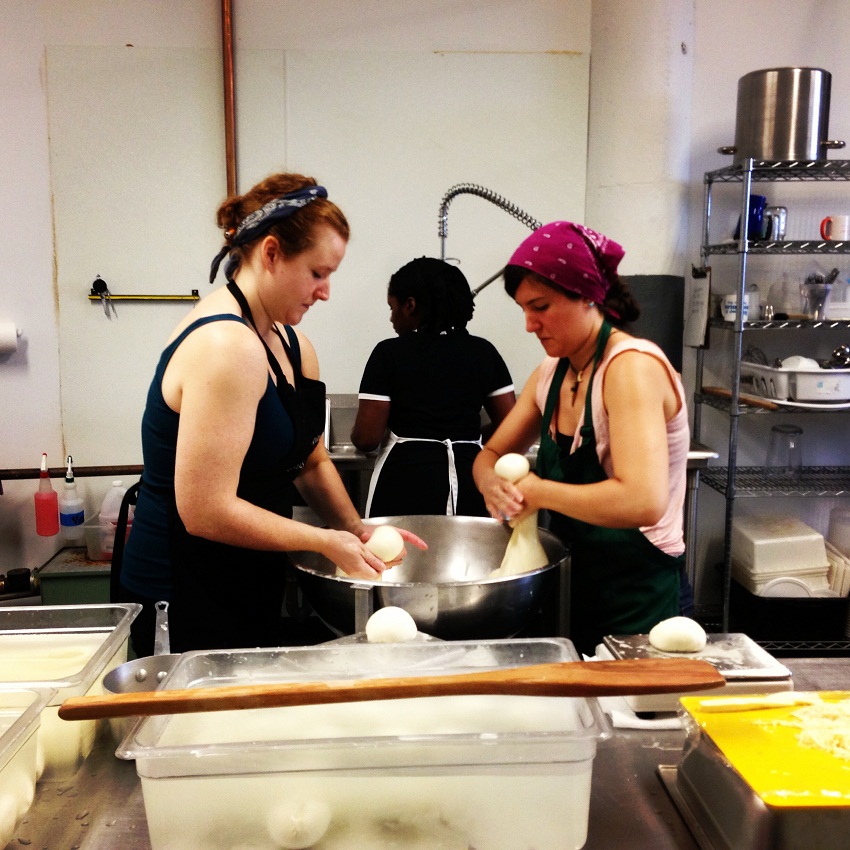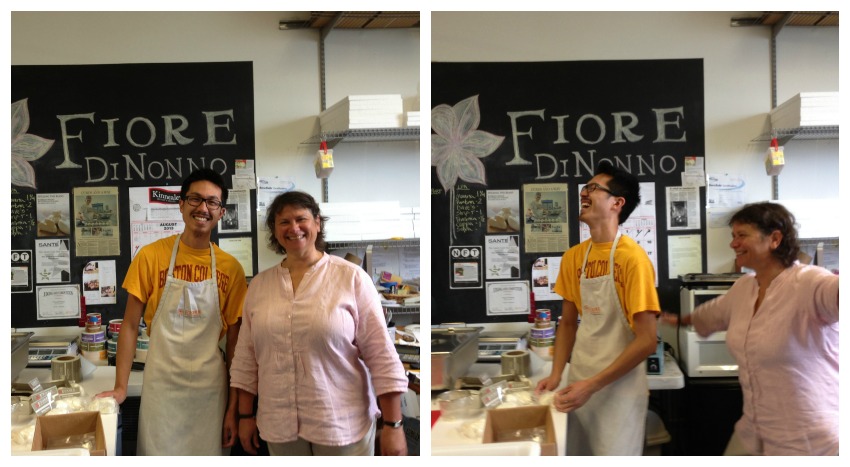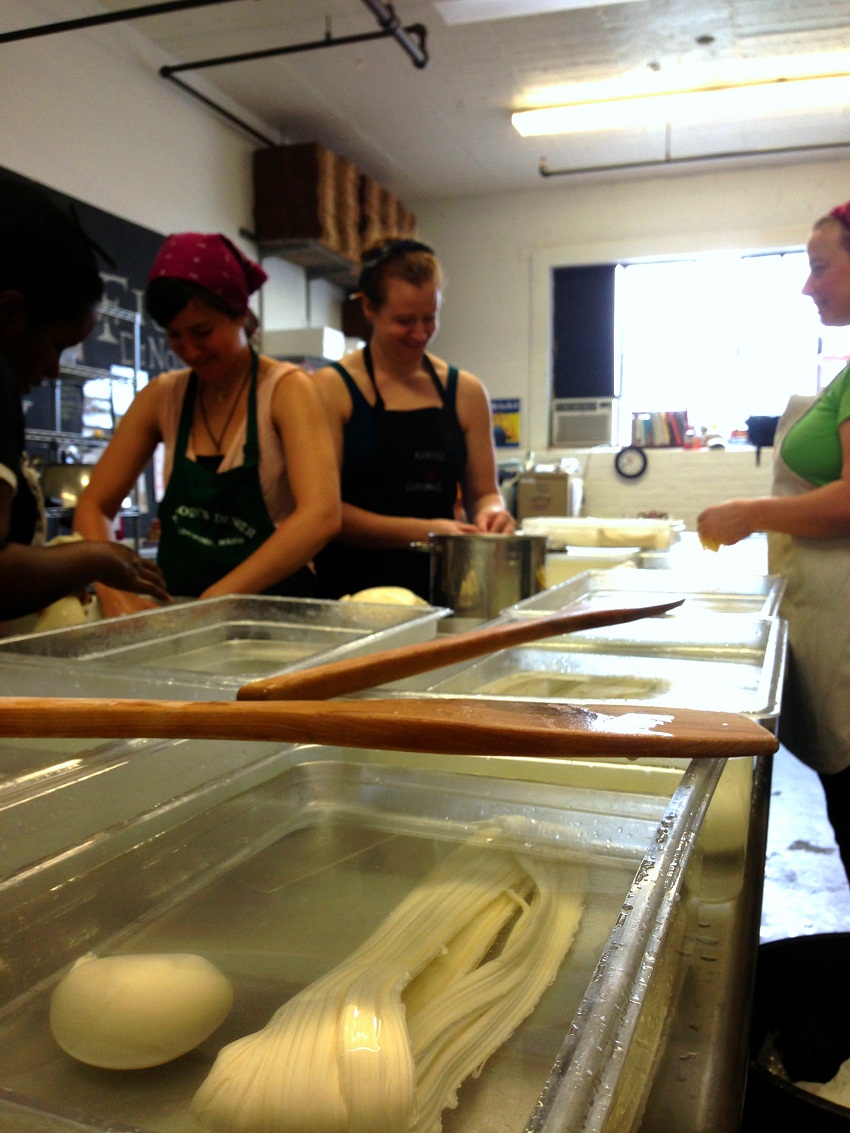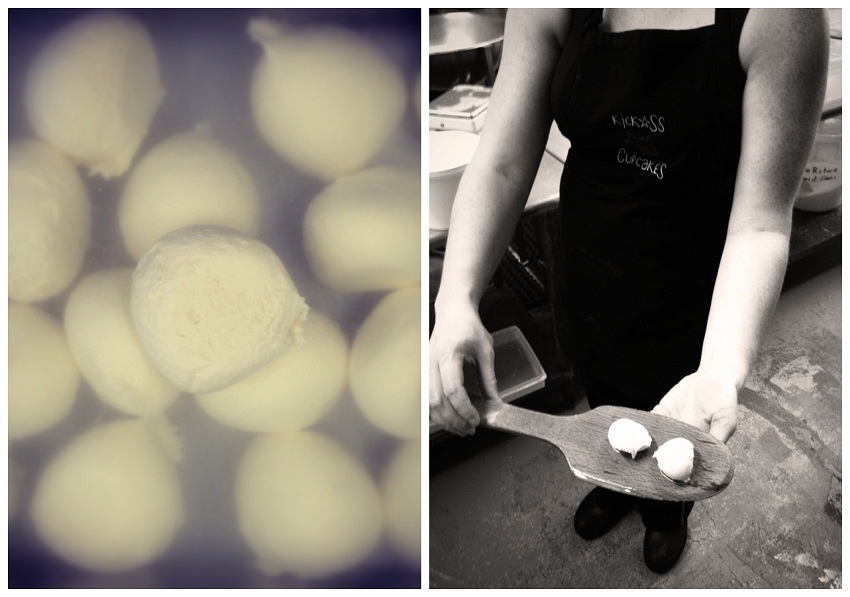Supply Chain: Mozzarella Magic at Somerville’s Fiore di Nonno
Welcome to Supply Chain, where we go behind the plate to get a feel for the day-to-day of Boston’s most relied-upon restaurant purveyors.
“Be sure to watch your step,” says Lourdes Smith, mozzarella maven and owner of Somerville’s Fiore di Nonno, as we enter her tiny warehouse kitchen in Windsor Place, “the floor might be slick with butterfat in some places.”
Now that’s what I’m talking about.
Inside, a staff of five looks up from a table running down the middle of the room, laden with fresh mounds and lengths of cheese resting peacefully in tubs of water. “This is my home away from home,” Smith says proudly. “And this is my crew.”
I’ve caught her on her first vacation since opening the business—after eight years, she has finally nurtured a team she feels she can safely leave the operation with. Annie Rettman, Pip Young (soon departing back to her Australian homeland, they tell me sadly), Lauren Murphy, Korsha Wilson, and Cameron Yu single-handedly craft the hundreds upon hundreds of pounds of mozzarella that we go through every week in area restaurants.
“Plus, we eat half a pound a day, at least,” Lauren quips, and the rest nod emphatically, grinning. Annie pinches off a piece from the batch she’s working on and brings it over; it is impossibly soft and pliant, with heady notes of earthy, buttery cream. I’ve never had mozzarella like this before, and half a pound is starting to sound conservative.
Smith’s grandfather, the youngest in a family of cheesemakers, arrived in America from Italy in 1908. In 1913, his father opened Fiore’s in Hoboken, a spot that became a go-to for the Sinatra family and a staple in the neighborhood. By 1927, Smith’s grandfather had taken it over, and by the time Smith had decided to bring old-world technique and flavor to Boston, the Hoboken store’s current owner, John Amato (previously the store’s loyal stock clerk) welcomed her with open arms—and passed along her grandfather’s cheesemaking technique.
Smith has been in the food industry in some capacity for over 30 years—she was previously a pastry chef who staged at Le Cirque with Jacques Torres, served as opening sous and pastry chef at Les Zygomates, and did a stint as Panera Bread’s Concept Project Manager. She says that she only realized cheese was her calling after she left the corporate world and was searching for a new purpose.
“I had watched my grandfather make it as a child, and I have these memories of eating this fresh mozzarella as a kid, but it was something we all took for granted,” she says.
She partnered with Shy Brothers Farm in Westport to recreate her grandfather’s token recipe, to stellar results: the morning’s milk is pasteurized, and then vinegar is added. Shy Brothers then curdles the milk, sets it with vegetarian rennet, and then drains it for 24 hours. It’s molded and set into blocks, which are then sent to Smith.
If you’re the kind of cheese geek who likes to get down into the scientific nitty-gritty, then here’s a tidbit for your next dinner party: the protein structure of curd is like a layer cake, Smith explains, meaning there’s a layer of protein, then a layer of butterfat, then a layer of protein, and so on. Smith’s process coaxes as much of the butterfat into the surface of the cheese as possible, by sloooowly stretching it with wooden paddles once it reaches its melting point in hot water. The butterfat doesn’t leach into the water, and protein structure doesn’t collapse, which yields a cheese that possesses both a soft, pillowy texture and a satisfying chew. The shaped mozzarella is then finished in a brine to give it just a hint of zingy salinity, bringing out the high notes of the milk.
Smith slaps a lid on a bucket of whey for newest kid on the block, Ribelle, where Tim Maslow uses it in addition to her stracciatella. Smith’s client roster, which includes 22-30 accounts at any given time, is constantly changing since she has no standing inventory. Chefs call in at 7 a.m. the day of, place their order, and it is delivered later that day for that night’s service. In the winter, Fiore di Nonno’s produces about 600 pounds of cheese a week. In the summer, that number jumps to 2,000 pounds.
“What matters to us here is the seasons,” she says. “The seasons always alter the milk, and right now is the best time to eat fresh mozzarella. The butterfat content is high, the cows have been eating the grass, it’s been raining…it just makes for the most beautiful flavor.”
At the moment, Annie is working through a large batch of taffy-like mozzarella with a short paddle, and Pip is in the midst of making stracciatella—freshly shredded mozzarella that she pulls apart by hand, then dunks in warm, salted cream. It is, predictably, mind-blowingly indulgent and comforting.
Fiore di Nonno can’t survive on mozzarella alone, which is why Smith began branching out with this stracciatella (which won top soft unripened cheese at the 2011 American Cheese Society Awards), a scamorza (low-moisture mozzarella), yogurt, burrata, string cheese, and a twist on crescenza (a soft, creamy cheese) that resulted from a special request from Meghann Ward of Coppa. So far, the tangy, creamy concoction has been a hit with both the farmer’s market crowd and her chef devotees.
“I love working with chefs because I offer them the opportunity to develop a flavor profile,” she says, pointing out a few burrata flavors borne out of recent partnerships: honey-lavender and chili for Louis DiBiccari (during his Sel de la Terre days), za’atar for Ana Sortun, and orange-fennel for Will Gilson when he was at Garden at the Cellar. “I really like having that creative moment with someone.”
Sortun, who first met Smith when the two were neighbors in Lincoln ten years ago and has collaborated with her on a number of cheeses since, has remained one of Fiore di Nonno’s powerhouse supporters. “She’s done an amazing job at growing her business, and it hasn’t been easy,” she says. “She challenges herself to stay perfect and really uses great judgment as to the integrity of the ingredients. It’s remarkably consistent.”
For the chef who gave sophisticated Middle Eastern cuisine its legs in this city, supporting someone like Smith and something like her small-batch, always made-to-order product is, in her words, life or death. “That’s what it’s all about,” she says. “Being close to where your sources are from means better quality ingredients. You can be a magician, but if you don’t have quality ingredients…plus, it also feels richer to know the people involved.”
Before I leave, Annie and Pip pull me aside. “She’ll never tell you this herself,” they say in hushed tones, “but a big part of this is the respect that she shows all of us.” When they arrived, Smith sat them down and told them that she knew how things could go down in a kitchen, but that she could promise them it would never be that way. The love they have for her, and one another—and that damn heavenly cheese— is staggering.
“She puts her heart and soul into it,” Sortun adds. “That’s really why it’s exceptional.”






